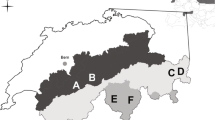Summary
The roles of thermal and hydric stress in habitat selection by two species of short-horned grasshoppers was investigated through field and laboratory studies and computer simulation experiments. Psoloessa delicatula was found to possess an elaborate repertoire of thermoregulatory postures and shade seeking behavior. This grasshopper was found in habitats in the shortgrass prairie in which bare patches of ground were common. It was found to regulate its body temperature to a relatively constant level over the course of a sunny day. Eritettix simplex was found in patches of dense vegetation, and its body temperature was usually similar to ambient temperature. During controlled laboratory experiments, E. simplex nymphs lost water rapidly and thus were presumed to be restricted to more mesic environments where desiccation stress is less. A thermal energy budget model was constructed and showed that the habitat selected by P. delicatula would allow behavioral thermoregulation whereas the habitat selected by E. simplex should preclude regulation of body temperature by behavioral means.
Similar content being viewed by others
References
Abramsky, Z., Tracy, C.R.: Population biology of a “noncycling” population of prairie voles. Ecology (in press 1978)
Ahern, B.A., Hadley, N.F.: The effects of temperature and humidity on water loss in two Tenebrionid beetles, Eleodes armata and Cryptoglossa verrucosa. Comp. Biochem. Physiol. 30, 730–749 (1969)
Bhatnagar, K.N., Pfadt, R.E.: Growth density, and biomass of grasshoppers in the shortgrass and mixed-grass association. US/IBP Grassland Biome Tech. Rep. No. 225, Colorado State Univ., Fort Collins, 120 pp (1973)
Casey, T.M.: Activity patterns, body temperature and thermal ecology in two desert caterpillars (Lepidoptera: Sphingidae). Ecology 57, 485–497 (1976)
Church, N.S.: Heat loss and the body temperatures of flying insects. I. Heat loss by evaporation of water from the body. Exptl. Biol. 37, 171–185 (1959)
Clench, H.K.: Behavioral thermoregulation in butterflies. Ecology, 47, 1021–1034 (1966)
Dickinson, C.E., Dodd, J.L.: Phenological pattern in the shortgrass prairie. Am. Midl. Nat. 96, 367–378 (1976)
Digby, P.S.B.: Factors affecting the temperature excess of insects in sunshine. J. Exptl. Biol. 32, 279–298 (1955)
Edney, E.B.: The body temperature of Tenebrionid beetles in the Namib Desert of southern Africa. J. Exptl. Biol. 55, 253–272 (1971a)
Edney, E.B.: Some aspects of water balance in Tenebrionid beetles and a thysanuran from the Nambi Desert of southern Africa. Physiol. Zool. 44, 61–76 (1971b)
Gates, D.M.: Energy exchange in the biosphere, 151 pp. New York: Harper 1969
Hadley, N.F.: Micrometeorology and energy exchange in two desert arthropods. Ecology 51, 434–444 (1970)
Hamilton, W.J., III: Competition and thermoregulatory behavior of the Namib Desert Tenebrionid beetle genus Cardiosis. Ecology 52, 810–822 (1971)
Heath, J.W.: Temperature responses of the periodical “17-year” Cicada, Magicicada cassini (Homoptera, Cicadidae). Am. Midl. Nat. 77, 64–76 (1967)
Heath, J.E., Wilkin, P.J.: Temperature responses of the desert cicada, Diceraprocta apache (Homoptera, Cicadadae). Physiol. Zool. 45, 238–246 (1970)
Heath, J.E., Wilkin, P.J., Heath, M.S.: Temperature responses of the cactus doger. Cacama valvata (Homoptera, Cicadidae). Physiol. Zool. 45, 238–246 (1972)
Henwood, K.: A field-tested thermoregulation model for two diurnal Namib Desert tenebrionid beetles. Ecology 56, 1329–1342 (1975a)
Henwood, K.: Infra-red transmittance as an alternative thermal strategy in the desert beetle Onymacris plana. Science 189, 993–994 (1975b)
Holm, E., Edney, E.B.: Daily activity of Namib Desert arthropods in relation to climate. Ecology 54, 45–56 (1973)
Hyder, D.N., Bement, R.E., Remmenga, E.E., Hervey, D.F.: Ecological response of native plants and guidelines for management of short-grass range. USDA Agric. Res. Serv. Tech. Bull. No. 1503, Washington, D.C., 87 pp. (1975)
Kirchner, T.B.: The effects of resource enrichment on the diversity of plants and arthropods in a shortgrass prairie. Ecology 58, 1334–1344 (1977)
Klipple, G.E., Costello, D.F.: Vegetation and cattle responses to different intensities of grazing on shortgrass ranges on the Central Great Plains. USDA Tech Bull. No. 1216, Washington, D.C., 82 pp. (1960)
Kowalski, G.J., Mitchell, J.W.: Heat transfer from spheres in the naturally turbulent, outdoor environment. J. Heat Transfer 98, 649–653 (1976)
Lauenroth, W.K., Dodd, J.L.: Response of native grassland legumes to water and nitrogen treatments. J. Range Manage. (in press)
Lauenroth, W.K., Sims, P.L.: Evapotranspiration from a shortgrass prairie subjected to water and nitrogen treatments. Water Res. Res. 12, 437–442 (1976)
May, M.L.: Thermoregulation and adaptation to temperature in dragonflies (Odonata:Anisoptera). Ecol. Monogr. 46, 1–32 (1976)
McCullough, C.E., Porter, W.P.: Computing clear day solar radiation spectra for the terrestrial ecological environment. Ecology 52, 1008–1015 (1971)
Pepper, J.H., Hastings, E.: The effects of solar radiation on grasshopper temperatures and activities. Ecology 33, 96–103 (1952)
Porter, W.P., Gates, D.M.: Thermodynamic equilibria of animals with environment. Ecol. Monogr. 39, 245–270 (1969)
Riechert, S.A., Tracy, C.R.: Thermal balance and prey availability: Bases for a model relating web-site characteristics to spider reproductive success. Ecology 56, 265–284 (1975)
Scott, J.R.: Thermal biology of the wandering garter snake. Ph. D. Dissertation, Colorado State Univ, Fort Collins, Colorado, 247 pp. (1978)
Seymour, R.S.: Convective and evaporative cooling in sawfly larvae. J. Insect Physiol. 20, 2447–2457 (1974)
Shaw, J., Stobbart, R.H.: The water balance and osmoregulatory physiology of the desert locust (Schistocerca gregaria) and other desert and xeric arthropods. Symp. Zool. Soc. Lond. 31, 15–38 (1972)
Tibbals, E.C., Carr, K., Gates, D.M., Kreith, F.: Radiation and convection in conifers. Am. J. Bot. 51, 529–538 (1964)
Tracy, C.R., Tracy, B.J., Dobkin, D.S.: The role of posturing in behavioral thermoregulation by black dragons (Hagenius brevistylus Selys.). Physiol. Zool. (submitted)
Waldschmidt, S.: Monthly variation in thermoregulatory behaviors and space utilization in the lizards Uta stansburiana and Sceloporus undulatus. M.S. Thesis, Colorado State Univ., Fort Collins, Colorado, 75 pp. (1978)
Waloff, Z.: Field studies on solitary and transient desert locusts in the Red Sea area. Anti-Locust Bull. No. 40, 91 pp. (1963)
Wiens, J.A., Innis, G.S.: Estimation of energy flow in bird communities: A population bioenergetics model. Ecology 55, 730–746 (1974)
Author information
Authors and Affiliations
Rights and permissions
About this article
Cite this article
Anderson, R.V., Tracy, C.R. & Abramsky, Z. Habitat selection in two species of short-horned grasshoppers. Oecologia 38, 359–374 (1979). https://doi.org/10.1007/BF00345194
Received:
Issue Date:
DOI: https://doi.org/10.1007/BF00345194




